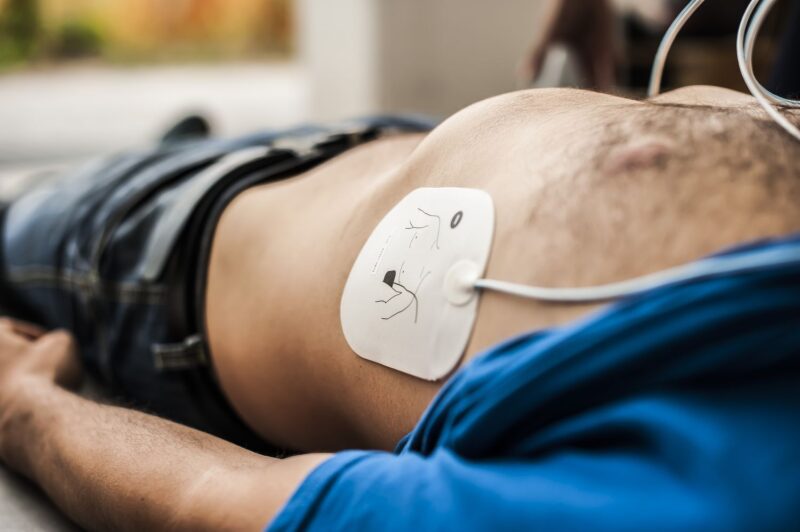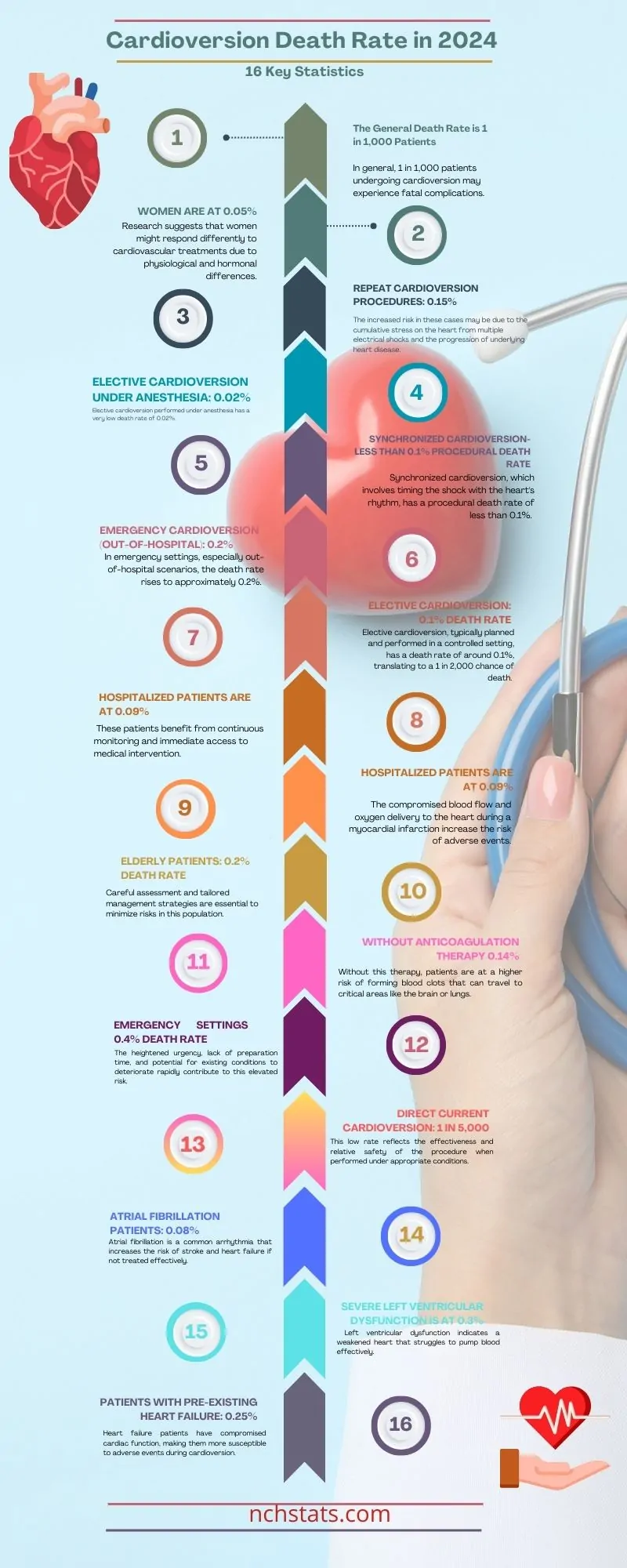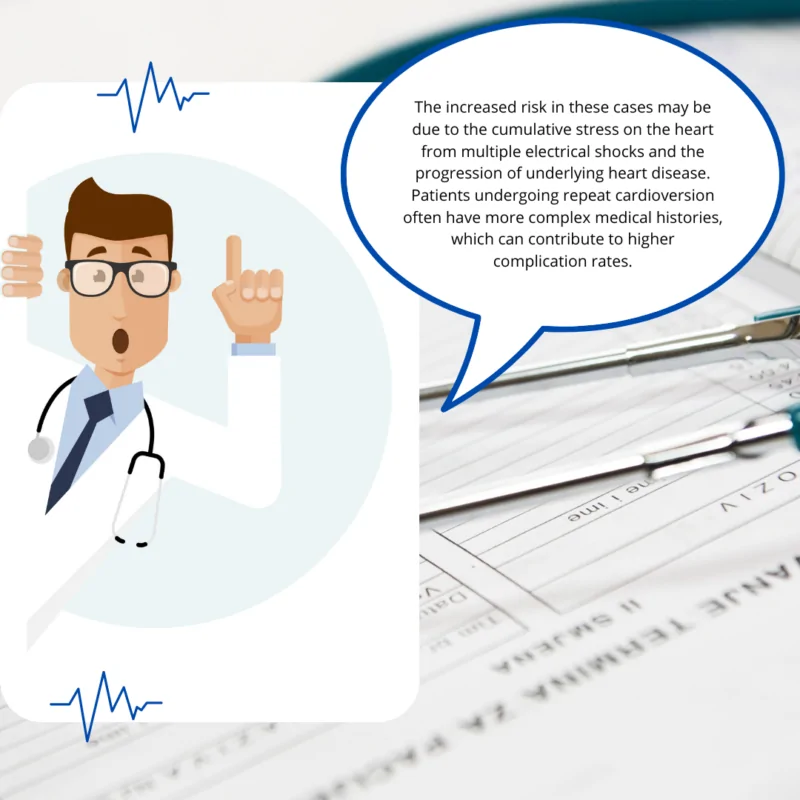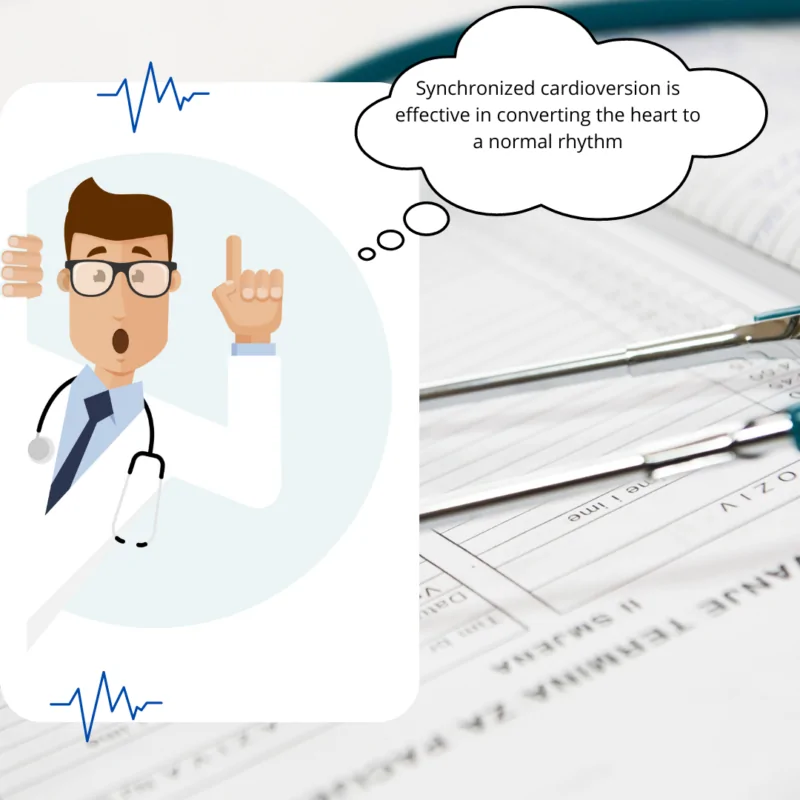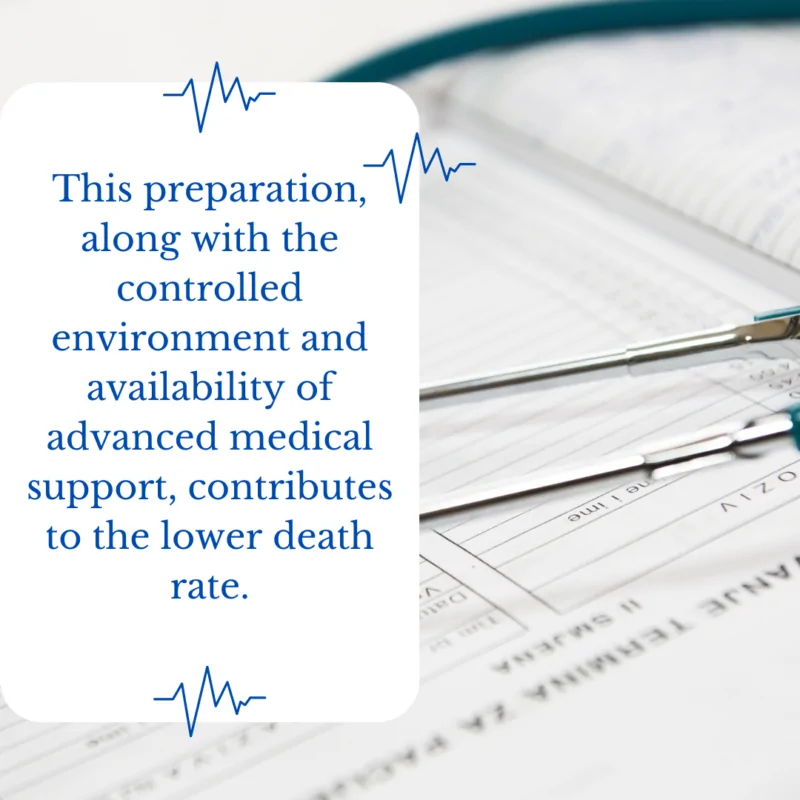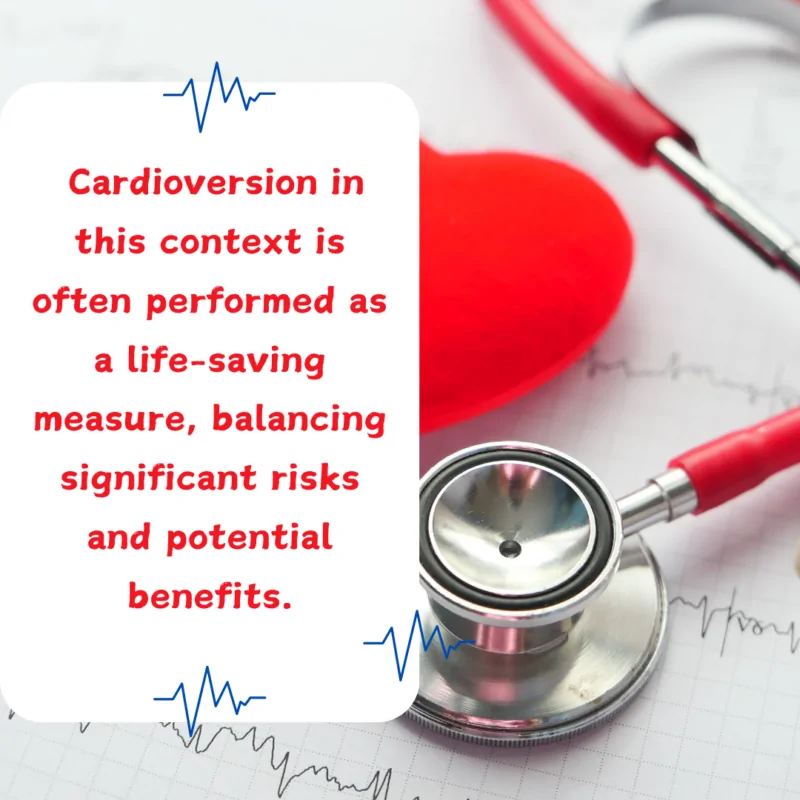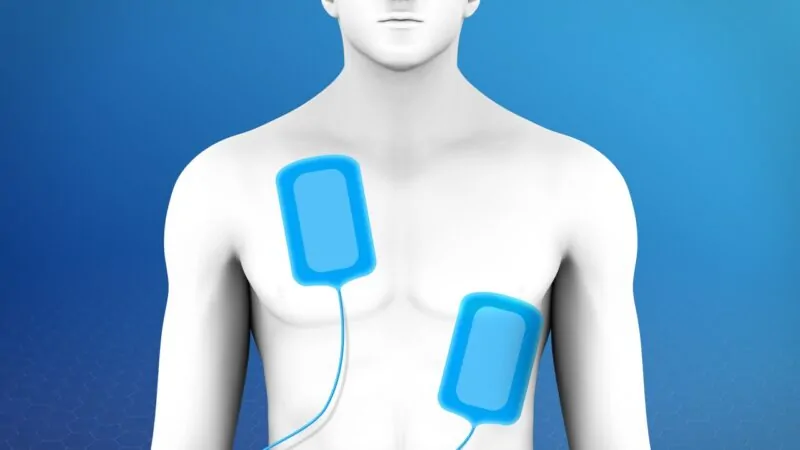Cardioversion, a medical procedure used to restore normal heart rhythms in patients with arrhythmias, carries various risks depending on several factors. Understanding these risks is crucial for informed decision-making.
This article provides key statistics on cardioversion death rates in 2024, offering valuable insights in an engaging and accessible manner.
Table of Contents
Toggle1. The General Death Rate is 1 in 1,000 Patients
In general, 1 in 1,000 patients undergoing cardioversion may experience fatal complications. This statistic highlights the inherent risks of the procedure. Cardioversion is often used to treat conditions like atrial fibrillation and flutter, which are serious and potentially life-threatening if untreated.
The procedure involves delivering an electrical shock to the heart to reset its rhythm, which can occasionally lead to severe complications such as stroke, heart attack, or sudden cardiac arrest.
2. Women are at 0.05%
Women undergoing cardioversion have a death rate of approximately 0.05%. Research suggests that women might respond differently to cardiovascular treatments due to physiological and hormonal differences.
Additionally, women typically develop cardiovascular diseases at older ages compared to men, potentially impacting the outcomes of procedures like cardioversion. This lower death rate could also reflect differences in the prevalence and severity of heart conditions between genders.
3. Repeat Cardioversion Procedures: 0.15%
For patients who undergo repeat cardioversion procedures, the death rate increases to around 0.15%. Repeat procedures are typically necessary when the initial cardioversion fails to maintain a normal heart rhythm.
The increased risk in these cases may be due to the cumulative stress on the heart from multiple electrical shocks and the progression of underlying heart disease. Patients undergoing repeat cardioversion often have more complex medical histories, which can contribute to higher complication rates.
4. Elective Cardioversion Under Anesthesia: 0.02%
Elective cardioversion performed under anesthesia has a very low death rate of 0.02%. Anesthesia helps in minimizing patient movement and discomfort during the procedure, which can lead to fewer complications. The controlled environment of an elective procedure, along with pre-procedure evaluations and monitoring, significantly enhances patient safety.
This setting allows for thorough preparation, including anticoagulation therapy to prevent blood clots and other preemptive measures to mitigate risks.
5. Synchronized Cardioversion- Less Than 0.1% Procedural Death Rate
Synchronized cardioversion, which involves timing the shock with the heart’s rhythm, has a procedural death rate of less than 0.1%. This technique is used to treat arrhythmias like atrial fibrillation, where precise timing of the electrical shock ensures that it coincides with the R-wave of the ECG, reducing the risk of inducing ventricular fibrillation.
Synchronized cardioversion is effective in converting the heart to a normal rhythm while minimizing complications, making it a preferred method for certain arrhythmias.
6. Emergency Cardioversion (Out-of-Hospital): 0.2%
In emergency settings, especially out-of-hospital scenarios, the death rate rises to approximately 0.2%. These situations are often chaotic and lack the controlled environment of a hospital. Patients undergoing emergency cardioversion typically have severe and unstable arrhythmias, increasing the risk of complications.
The delay in reaching a medical facility and the immediate need for intervention contribute to the higher mortality rate in these cases.
7. Elective Cardioversion: 0.1% Death Rate
Elective cardioversion, typically planned and performed in a controlled setting, has a death rate of around 0.1%, translating to a 1 in 2,000 chance of death. Patients undergoing elective cardioversion are usually well-prepared, with thorough pre-procedure assessments and optimization of their medical condition.
This preparation, along with the controlled environment and availability of advanced medical support, contributes to the lower death rate.
8. Hospitalized Patients are at 0.09%
For patients already hospitalized, the cardioversion-associated mortality rate is about 0.09%. These patients benefit from continuous monitoring and immediate access to medical intervention.
Hospitalized patients are typically under strict medical supervision, which allows for early detection and management of potential complications. This setting provides a safety net that significantly reduces the risk of fatal outcomes during the procedure.
9. Acute Myocardial Infarction: 0.2% Death Rate
During an acute myocardial infarction (heart attack), the death rate for cardioversion is 0.2%. Patients experiencing a heart attack are in a highly vulnerable state, and the additional stress of cardioversion can exacerbate their condition.
The compromised blood flow and oxygen delivery to the heart during a myocardial infarction increase the risk of adverse events. Cardioversion in this context is often performed as a life-saving measure, balancing significant risks and potential benefits.
10. Elderly Patients: 0.2% Death Rate
Elderly patients undergoing cardioversion face a death rate of around 0.2%. Age-related factors such as decreased physiological resilience, presence of multiple comorbidities, and frailty contribute to this higher risk. The elderly typically have a more complex cardiovascular profile, which can complicate the procedure and recovery process.
Careful assessment and tailored management strategies are essential to minimize risks in this population.
11. Without Anticoagulation Therapy 0.14%
Patients not receiving anticoagulation therapy before cardioversion have a death rate of 0.14%. Anticoagulation therapy is crucial in preventing thromboembolic events, such as stroke, during cardioversion.
Without this therapy, patients are at a higher risk of forming blood clots that can travel to critical areas like the brain or lungs. Ensuring appropriate anticoagulation before the procedure is a key step in reducing the risk of fatal complications.
12. Emergency Settings 0.4% Death Rate
In emergency settings, the death rate for cardioversion increases significantly to 0.4%. The heightened urgency, lack of preparation time, and potential for existing conditions to deteriorate rapidly contribute to this elevated risk.
Emergency cardioversion is usually performed under less-than-ideal conditions, where immediate intervention is necessary to prevent imminent death, despite the higher risk of complications.
13. Direct Current Cardioversion: 1 in 5,000
Direct current cardioversion, a common method used to correct arrhythmias, has an immediate death rate of 1 in 5,000 procedures. This low rate reflects the effectiveness and relative safety of the procedure when performed under appropriate conditions.
Direct current cardioversion is widely used due to its ability to quickly restore normal heart rhythm, with a well-established safety profile in clinical practice.
14. Atrial Fibrillation Patients: 0.08%
For patients with atrial fibrillation, the death rate during cardioversion is approximately 0.08%. Atrial fibrillation is a common arrhythmia that increases the risk of stroke and heart failure if not treated effectively. Cardioversion is a key intervention for restoring normal rhythm and improving patient outcomes.
The low death rate in these patients highlights the procedure’s efficacy and safety in managing this condition.
15. Severe Left Ventricular Dysfunction is at 0.3%
Patients with severe left ventricular dysfunction face a higher death rate of around 0.3% during cardioversion. Left ventricular dysfunction indicates a weakened heart that struggles to pump blood effectively. The additional stress of cardioversion can lead to decompensation and severe complications in these patients.
Careful evaluation and tailored management are critical for minimizing risks in this high-risk group.
16. Patients with Pre-existing Heart Failure: 0.25%
For those with pre-existing heart failure, the death rate during cardioversion is about 0.25%. Heart failure patients have compromised cardiac function, making them more susceptible to adverse events during cardioversion.
Effective management of heart failure symptoms and optimization of medical therapy before the procedure is essential to reduce the risk of fatal outcomes.
In Summary
Cardioversion is a critical procedure for managing heart rhythm disorders, and understanding the associated death rates is essential for making informed decisions. While the statistics can seem daunting, the benefits of cardioversion often outweigh the risks, especially when performed in controlled settings with proper preparation and monitoring.
@doctorsood Have you seen this before? #atrialfibrillation #cardioversion #doctor #medicaltiktok


